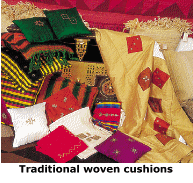|
By Roy Kietzman
 Supervising no fewer than 13 different handicrafts, Manama's Craft Centre is a key hub where both traditional and newer artisans are flourishing. Supervising no fewer than 13 different handicrafts, Manama's Craft Centre is a key hub where both traditional and newer artisans are flourishing.
Nearly 80 people are involved in projects which are as diverse as crafting jewellery, iron and wood products to producing dolls, preserved flowers, embroidered and crocheted goods as well as highly artistic Arabic calligraphy.
Though most of the workshops are located in the six-decade-old building which formerly housed Bahrain's first technical school, two dozen Bahraini women in Diraz, through wool weaving, are producing rugs, tapestries, cushions and yarn.
Twelve women in Muharraq keep alive the craft of fine embroidery on traditional apparel though they have now extended their needlework to tablecloths and other household goods.
The Craft Centre, entirely managed by Bahraini women, has become a favourite on tourist itineraries.
Aisha Matter, entrepreneur and promoter, also runs the centre to make certain that it responds both to the needs of the craft workers and the market.
"While many of the crafts were up and running for years in various parts of the island, we actually got our premises in March 1995 and swiftly began to move the various handicrafts into the workshops," she said.
The spacious, bi-level gallery attractively displays some of the wares.
Interestingly enough, while the centre does give active support to all craftwork by providing space to craftsmen in one of its 27 workshops, most of the projects aren't, strictly speaking, traditional.
Untraditional pottery, for example, is fashioned on the spot, quite unlike the handsome pieces that have been turned out in the A'ali village for generations.
Even more unusual is a stained-glass workshop which designs windows for hospitals, music institutions, mosques, churches, hotels and homes.
Some of the windows are of conventional dimensions while others are monumental, dramatically covering ceilings or rotundas in great public edifices.
A look around the stained-glass showroom will show you that there's a lot more to stained glass than meets the eye.
You'll see mirrors with floral, stained-glass trim along the frame, Tiffany-type lampshades and lovely ornamentation on chandeliers and other decor.
 Visitors to Bahrain couldn't believe that stained glass was actually produced on the island and wanted to take back a sample. But the goods, however beautiful, are admittedly bulky for suitcases. Visitors to Bahrain couldn't believe that stained glass was actually produced on the island and wanted to take back a sample. But the goods, however beautiful, are admittedly bulky for suitcases.
Stained-glass craftsman Geyad Hassan Jawad began recently to produce small table lamps with their colourful glass shades and even paperweights that tourists could more easily pack into things to take back home.
If you're lucky, you might be allowed into the workshop itself where Jawad's workers are busily cutting out coloured glass, following a design pattern, and fitting the pieces into metal panes to form symmetric or other artistic decorations.
The fine glass dust floating about and toxic odours during the fabrication process make the workshop a non-environmentally-friendly area for the casual visitor. But the gallery and the workshop showroom have scores of delightful products on show.
Jawad, who learned his craft in Wales in 1980 as a art and design student, is often able to take time to explain the careful processes involved in producing a concept from paper to flat or moulded finished product.
Constantly evolving in his use of craft, the Bahraini is fascinated with the architectural possibilities of stained glass as well as the flexibility and beauty it permits.
He also explores the techniques of melding the tones of coloured glass with the use of Arabic calligraphy.
Another project which is wonderfully interesting to view is the making of paper from palm fronds.
In the northern part of Bahrain, palm trees of various varieties are ubiquitous and provided the population in days of yore with material for thatching and boat hulls, strengthening building walls and covering ceilings, as well, of course, as dates and date syrup.
But no one had ever thought of using the long leaves - otherwise burned - to make paper. That is, until the Children's and Mothers Welfare Society adopted the project and began to produce paper, in a process not unlike that of making papyrus.
A half dozen women work at drying out the leaves, slicing them into long slivers.
After cooking the sliced leaves into a mash in a cauldron, the mixture goes into a couple of rinses from vat to vat until a silkscreen frame is dipped into a tub to extract a layer of the leaf soup which by now has the consistency of overcooked spinach though the colour is a rather ugly tan.
Pressing the excess water out of the frame of palm mash, the women let the rectangular product dry, iron it carefully into sheets of naturally produced paper which can then be used for greeting cards, folk art, invitations or bookmarks.
One Swiss lady viewing these naturally produced items exclaimed, "Oh, I think we must buy some of these things out of solidarity to the ladies."
Several textures, sizes and thicknesses of paper are produced, and, besides the Gallery, the palm-paper showroom has an abundant display of the artful products that the women have produced.
As environmentalists become more and more concerned with the use of timber to make our daily paper, it is heartening to know that remarkable artistic paper products can be manufactured in Bahrain from what quite likely would've ended up in the bonfire.
RELATED LINKS:
Drawing on the past
Feats of clay
|

